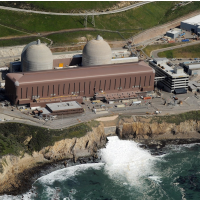End of Nuclear Power in Sight for California; Renewable Energy to Fill Void
 Diablo Canyon nuclear power plant (photo: Mark Ralston, Getty Image)
Diablo Canyon nuclear power plant (photo: Mark Ralston, Getty Image)
By Don Debenedictis, Courthouse News Service
SAN FRANCISCO (CN) — California's last nuclear power plant is expected to close within the decade, a regional utility giant said Tuesday.
Pacific Gas & Electric Co. announced that it plans to shutter its Diablo Canyon facility in 2025 rather than renew licenses to keep its reactors operating.
The utility said it will replace the power generated by the plant with projects that don't produce greenhouse gases, including renewable energy sources, increasing energy efficiency and new storage capabilities.
The stunning proposal from PG&E comes out of an agreement with environmental groups and labor unions. The closure plan still needs approval from the California Public Utilities Commission and other regulators.
"This is an absolutely historic agreement," said Damon Moglen, a senior strategist with the Friends of the Earth, who participated in the negotiations.
In a statement, the environmental group's president Erich Pica added that the agreement "sets a date for the certain end of nuclear power in California and assures replacement with clean, safe, cost-competitive, renewable energy, energy efficiency and energy storage."
The 31-year-old Diablo Canyon plant had been under fire for years over safety concerns, including the fact that it sits very near several earthquake fault lines.
The San Onofre nuclear power plant in northern San Diego County was shut down in 2012 following a leak of radioactive material and the discovery of prematurely worn-out parts. Two other nuclear plants in the state had closed in 1976 and 1989.
In its press release, PG&E said the proposal to close Diablo Canyon grows out of shifts in the state's energy market.
"California's energy landscape is changing dramatically with energy efficiency, renewables and storage being central to the state's energy policy," CEO Tony Earley said in the press release.
The changes mean that "Diablo Canyon's full output will no longer be required," Earley said.
Currently, the plant produces about 20 percent of the power used by PG&E customers in Northern and Central California, equaling about 9 percent of the state's total energy output, according to news accounts.
The changes in the energy landscape Earley mentioned include some of the toughest environmental regulations in the nation. For instance, a state policy requires utilities to increase the amount of power from renewable sources they sell to 50 percent by 2030. Another new law doubles energy efficiency goals for utilities as a means to reduce demand for electricity.
In fact, demand for electricity is already trending down and could drop by 30 percent to 60 percent in the next decades, according to Moglen.
California utilities are losing customers through the spread of rooftop solar panels and from a system called "community choice aggregation" that allows local jurisdictions to buy electricity cheaper directly from generators than from the big utility companies.
The growth of wind and solar farms also makes renewable energy generation more available, PG&E noted.
Yet the Diablo Canyon plant hinders shifting to renewable energy, according to Moglen. That's because the plant produces a constant stream of power, requiring wind and solar to be reduced when too much power is generated occasionally.
"Diablo Canyon nuclear power plant actually obstructs that renewable energy," he said. "If you want to absorb more [renewable] energy, you've got to remove that obstruction."
Besides PG&E and Friends of the Earth, other organizations that negotiated the agreement include the International Brotherhood of Electrical Workers, the Coalition of California Utility Employees, the Natural Resources Defense Council, Environment California and the Alliance for Nuclear Responsibility.
Moglen noted that the various sides "have been fighting each other over this plant for many decades."
The groups "came to this agreement with some different perspectives — and we continue to have some different perspectives," Earley said in the press release. "But the important thing is that we ultimately got to a shared point of view about the most appropriate and responsible path forward with respect to Diablo Canyon and how best to support the state's energy vision."
The next steps include winning approval from the State Lands Commission by 2018 for PG&E to renew its lease on the Diablo Canyon site and approval from the California Public Utilities Commission of several financial aspects of the plan.
PG&E said it does not believe the closure of Diablo Canyon or the shift to renewable sources will cause rates to go up.
To Learn More:
Money to Decommission San Onofre Nuclear Plant Used Instead to Store Waste on Site (by Ken Broder, AllGov California)
Damage at California Nuclear Power Plant Worse than Earlier Reported (by Ken Broder, AllGov California)
- Top Stories
- Controversies
- Where is the Money Going?
- California and the Nation
- Appointments and Resignations
- Unusual News
- Latest News
- California Forbids U.S. Immigration Agents from Pretending to be Police
- California Lawmakers Urged to Strip “Self-Dealing” Tax Board of Its Duties
- Big Oil’s Grip on California
- Santa Cruz Police See Homeland Security Betrayal in Use of Gang Roundup as Cover for Immigration Raid
- Oil Companies Face Deadline to Stop Polluting California Groundwater





